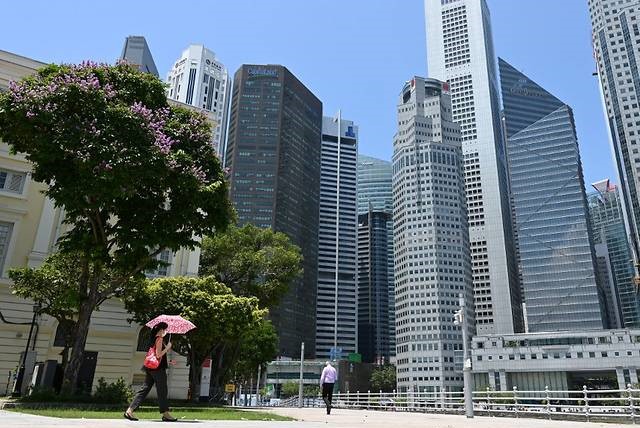
A woman walks along a promenade at the Raffles Place financial business district in Singapore on Apr 20, 2021.
SINGAPORE: There is still a possibility for Singapore to chalk up growth of 6 per cent or more this year, according to economists who do not expect the recently imposed COVID-19 curbs to throw the economic recovery off course for now.
These economists have pencilled in full-year estimates of 6 per cent to 7 per cent growth, even as authorities on Tuesday (May 25) opted to maintain an earlier forecast for gross domestic product (GDP) to be between 4 per cent and 6 per cent for 2021.
The authorities said last month that it was possible for Singapore’s rebound in 2021 to exceed the upper end of this forecast range.
But since then, the country has witnessed a spike in community infections and active clusters, prompting the roll-out of tighter curbs such as a ban on dine-ins and a cap of two people for social gatherings until Jun 13.
The Ministry of Trade and Industry (MTI) warned on Tuesday of “heightened uncertainties” caused by the pandemic at home and abroad. The latest slew of tighter restrictions and border controls are also likely to result in a recovery that is “more uneven than earlier expected”.
While it is still possible for the Singapore economy to outperform the official forecast range, there are also “significant downside risks”, said MTI, adding that a review of the forecast will be done in August when it has more data and greater clarity on the COVID-19 situation.
Barclays Bank economist Brian Tan said authorities have held back from revising the official forecast range “out of an abundance of caution” following the spike in local infections and accompanying curbs. But he is keeping to his full-year estimate of 7 per cent.
“Our own projections suggest that given the stronger-than-expected GDP in the first quarter, full-year growth would already be on track to hit 6.7 per cent even if seasonally adjusted GDP levels flat-lined for the rest of the year,” Mr Tan told CNA.
“So on that basis, an upgrade was possible … but I think the Government has decided to take a more cautious route and to wait for more data before making an official announcement.”
Other economists are also holding on to their estimates of above 6 per cent growth, unless current curbs are extended or further tightened.
“A growth downgrade is warranted only if the COVID-19 situation worsens and triggers ‘circuit breaker’ measures or an extension of the heightened measures for another month,” said May Bank Kim Eng economists Chua Hak Bin and Lee Ju Ye, who expect full-year growth to be at 6.2 per cent.
Similarly, DBS senior economist Irvin Seah wrote in his report: “Unless the (tighter rules) get extended significantly or new stiffer measures are introduced, we are maintaining our existing growth forecast of 6.3 per cent for 2021.”
SECOND QUARTER GDP TO HIT 15%: ECONOMISTS
The Singapore economy has thus far kicked off 2021 on a strong footing, with first-quarter GDP expanding by 1.3 per cent on a year-on-year basis.
This, announced by MTI on Tuesday, was significantly higher than the advance estimates of 0.2 per cent growth and marked the economy’s first quarterly growth in a year since the pandemic erupted.
Manufacturing, which makes up one-fifth of the local economy, was a standout performer with a 10.7 per cent expansion, even faster than the 10.3 per cent growth in the earlier quarter. Other sectors that provided support include finance and insurance, and wholesale trade.
For the April to June quarter, economists told CNA that they are expecting an outsized growth figure as high as 15 per cent from a year ago.
One reason is the low base effect, given how the economy slumped 13.3 per cent during the second quarter last year due to the circuit breaker which shut down schools and most workplaces.
The current measures, which authorities termed Phase 2 (Heightened Alert), are also not likely to materially impact the bright spots in the economy, such as manufacturing and wholesale trade.
“We think manufacturing and wholesale trade will likely remain resilient as external demand improves, driven by the recovery and reopening in the United States, China and Europe,” said Dr Chua and Ms Lee from Maybank Kim Eng.
And even though some sectors will feel the bite from the tightened measures – namely retail, food and beverage as well as construction – they represent less than 10 per cent of the overall economy, they added.
The latest measures are also not as severe as those implemented under the circuit breaker, said Mr Tan.
High-frequency indicators such as Google mobility data suggest the drop in community mobility has been “relatively limited”, the Barclays economist noted. The rapid digital adoption last year also helped businesses to be better prepared as work from home became the default arrangement amid the tighter measures.
Mr Alex Holmes, from research firm Capital Economics, also said there are a number of reasons to think that economic activity will be resilient.
For one, construction sites that were shut last year – due to the surge in COVID-19 cases in foreign worker dormitories – remain open.
Others include how e-commerce is now better developed than before the pandemic and should “partially offset falling in-person sales”, as well as a prompt step-up in support measures for businesses affected.
“Provided restrictions are lifted on schedule, the economy should make up most of the lost ground in the second half of 2021,” said Mr Holmes.
That said, some concerns remain, said some economists.
“We remain concerned on how COVID-19-related risks may evolve in the year ahead,” said UOB economist Barnabas Gan, who has a full-year growth forecast of 5.5 per cent.
“It is still uncertain if Singapore will exit on schedule from the current (restrictions) on Jun 13 and should it exit, the degree of social distancing measures then.”
Mr Gan added that headwinds to growth may intensify if the measures are extended, given the further drag on the domestically-oriented industries such as retail, F&B, construction and marine and process sectors.
With these uncertainties, the risk is for the local labour market to hit “a temporary speed bump” following some stabilisation, said OCBC’s head of treasury research and strategy Selena Ling.
Mr Tan also said that improvements in the jobs market will likely “continue to be slow and challenging” amid an uneven economic recovery.
“What makes it difficult is that sectors that have been doing well tend to be either highly automated like manufacturing, or require quite technical skills,” he explained. “So you can’t just take a worker from one industry and drop them into another, and expect them to function from the get-go.”
Businesses may also prefer to go slow on hiring or choose to put off adding to their headcount entirely until the overall economic conditions improve, Mr Tan added.


